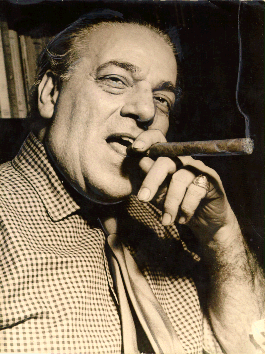

become the most celebrated Brazilian composer of all
time. His work not
only richly typifies the diverse and kaleidoscopic Brazilian scene but
also, in its abundance, originality, and vitality, provided the key which
unlocked Brazilian art music once and for all from the shackles of
European late-Romanticism.
After the death of his father in 1899, Villa-Lobos, determined to escape
the medical career planned for him by his mother, spent time playing
(probably cello and guitar) in the ad hoc musical groups which performed
and improvised in Rio's cafes, on street corners, and at parties and
weddings - the chtros. He then traveled in Brazil, absorbing musical
influences from his country's three main ethnic strands - Portuguese,
African and Amerindian. This all resulted in the realization that the
glorious aural amalgam which so impressed his soul was indeed the means
by which concert music in Brazil would be revitalized and given a voice
of its own.
After some success and much controversy as a composer in Brazil,
Villa-Lobos made his way in 1923 to Paris, at that time the cultural
center of Europe, where every aspiring musician, artist and writer felt
it obligatory at least to put in an appearance. The artistic ambience of
Paris during the 1920s was particularly suitable for the acceptance and
promotion of Villa-Lobos during his subsequent periods of residence
there, until a final departure in 1930. Indeed, even before his own
arrival several of his works were heard and applauded in the French
capital, played by his compatriots or by European artists who had met the
composer in Brazil. African music and jazz were particularly in vogue
and the strange sounds of the music of the East so beloved by Debussy and
Ravel still echoed loudly. The clear-cut, quixotic melodies of Milhaud
and Poulenc were favored, while Stravinsky's rhythmic vitality affected
everyone. Villa-Lobos's highly colored, strangely conceived, and
rhythmically assured music thus found an ideal home in Paris during the
1920s.
The fantasy piece for flute and cello, Assobio a Jato ('The Jet
Whistle'), was written in 1950 in New York and was first performed on 13
March 1950 in Rio de Janeiro. It is dedicated to Elizabeth and Carleton
Sprague Smith (flautist and musicologist), and continues Villa-Lobos's
predilection for writing high- and low-voiced instrumental duos. The
piece is primarily a musical joke, playing on the natural characteristics
of both instruments. Divided into three short movements, the colorfully
lyrical, bustling world of the eclectic Villa-Lobos is encapsulated here
in the fluid lines and virtuosity of both partners.
---SIMON WRIGHT 1989
Back to The Return of Are You Brave ? Festival